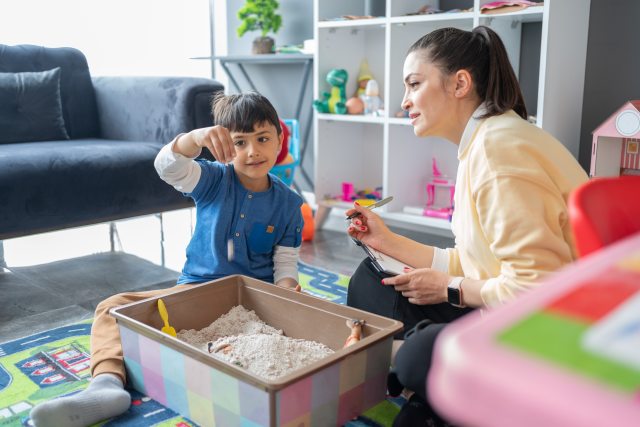Why do autism diagnoses seem more common now?

It’s not just due to greater awareness.
If it seems like autism is more common than it used to be, you’re right.
This diagnosis is now four times as common as it was 20 years ago. Consider a typical third-grade classroom. One child out of 36 is likely to have a diagnosis on the autism spectrum, according to estimates from the U.S. Centers for Disease Control and Prevention.
And while people are more aware of autism, awareness doesn’t account for such a dramatic increase.
Researchers are trying to find the causes. What factors contribute to the higher rate? And what can be done to help the person with autism and their family?
About autism
Autism spectrum disorder is a neurodevelopmental disorder that begins early in life. It impacts the way the brain functions in areas of social interaction, communications skills and behavior. Symptoms can look different in those affected.
A child’s autism can vary in type and intensity of behavior, which may include:
- Not being able to speak or form words.
- Sensitivities to certain foods (texture, taste, smell). This can include how clothing or certain textures feel next to the skin. It might also relate to sounds, light and other touch.
- Feeling mildly to extremely uncomfortable interacting with other people.
- Rigid behaviors and need for specific routines.
- Acting out physically or harming oneself or others.
- Intense reactions to minor changes in routine or surroundings.
“Every person with autism is unique and has a distinct set of strengths and challenges. The severity of symptoms varies widely. This can make it challenging to diagnose,” says Julie Cheek, MD, a pediatrician at PeaceHealth who provides autism assessments.
How autism is diagnosed
While there are adults diagnosed later with ASD, the condition begins early when the brain is developing.
Typically, you’ll see signs in children before they turn 3 years old. Often, a child is diagnosed by 5 years of age.
It’s usually diagnosed based on a child’s behavior and development. A doctor will observe the child and ask parents, caregivers, teachers and/or therapists questions about the child.
No biological test can confirm whether a child does or does not have autism. However, there are some observation tools doctors may use to help. They will assess for other conditions that may have autism like symptoms such as hearing/vison loss. They might also look for lead poisoning, specific genetic disorders like Down’s syndrome and other neurodevelopmental disorders like ADHD, anxiety and intellectual disability.
If you think a child may have ASD, here are a few signs to watch for:
- Little or no eye contact.
- Delays in learning to talk.
- Strong need for “sameness” or routine.
- Strong attachment to certain objects or highly specific interests
- Repetitive movements
Causes and contributing factors
From a statistical standpoint, ASD is more common since the guideline used by providers (DSM V criteria) uses a broader definition for diagnosis. Other conditions were previously split out from the ASD diagnosis.
In addition, people who work with or care for little ones now have better training in how to recognize autism. That means earlier diagnosis. There are also more opportunities now to evaluate children from Black or Hispanic communities that have in the past been underserved.
As for individual cases, experts say it’s extremely difficult to pinpoint causes of autism. There are likely many factors involved. Of those that are known, one or more of the following categories may contribute to the development of ASD:
- Genetic changes (mutations) that may cause or increase susceptibility to autism.
- Outside factors like infections or contact with chemicals or toxic substances in the environment may interact and alter genes.
- Other unidentified factors that are still being researched.
Studies clearly show that vaccines do not cause autism.
Since autism can’t be prevented, it’s important to recognize signs early. That way you can take appropriate steps to support the child.
Treating autism
“There is no ‘cure’ for autism. A combination of behavioral and medical interventions tailored to each child’s needs can help them use all their abilities and skills,” says Dr. Cheek.
Doctors and parents/families can try a combination of options, including:
- Behavioral training and management. This helps families learn to communicate, interact and teach the child new skills.
- Speech, occupational and physical therapies.
- Social skills training.
- Medications that treat specific symptoms and coexisting conditions: attention deficit hyperactivity disorders, anxiety, insomnia, aggression, self-harm or disruptive behaviors.
- Dance and art therapy.
People with ASD often have other common health conditions such as:
- Allergies
- Asthma
- Nutrition/dietary concerns
- Epilepsy
- Digestive and feeding disorders.
- Sleep disorders
Treatment for these can also help ASD-focused therapies.
Living with autism
For some, autism means they experience the world differently. It’s no better or worse, just different.
Even so, children with ASD may be more likely to experience bullying. They are also at higher risk for accidents, especially drowning. The National Autism Association offers training, handouts and other tangible tools to help keep kids safer.
Families with people who have ASD might find several organizations and forums like the Autism Society and Association for Autism and Neurodiversity helpful. Connecting with others who have similar experiences can be of value.
In recent years many communities are taking action to help kids and families with ASD feel more included. Some schools, libraries, museums, and stadiums now offer sensory rooms. This helps neurodivergent people manage their conditions in public spaces. Headphones are another option to block sound overload.
Adults with undiagnosed ASD have also benefited from what is being learned today. Read this article by a doctor with autism.
“If there’s a silver lining to the increase in autism being diagnosed, it’s that more people are becoming interested in knowing more about autism. That means more people are looking for ways to provide better support and understanding,” says Dr. Cheek.






